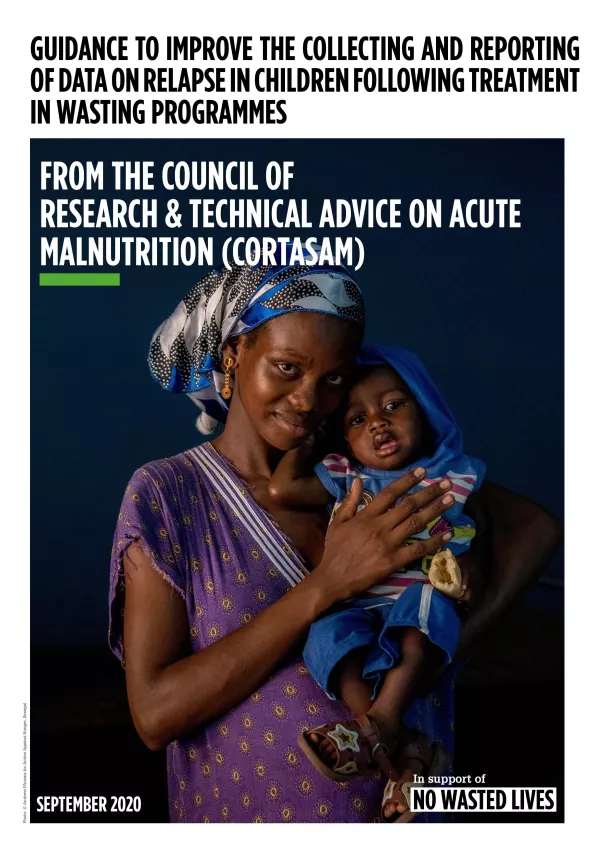Guidance To Improve The Collecting And Reporting Of Data On Relapse In Children Following Treatment In Wasting Programmes
Publication details
Background
In mid-2017, the Council of Research & Technical Advice on Acute Malnutrition (CORTASAM) led the implementation of a global research prioritisation exercise for the treatment of wasting1. Over 300 individuals from 63 countries and 167 organisations participated in this survey. This exercise identified key research areas that are priorities to achieve scale-up of treatment of wasting by 20202.
One of the top five global research priority questions focuses on relapse rates post-discharge from treatment for wasting; namely: "What are the rates and causal factors of post-discharge relapse from treatment across contexts? How can relapse be reduced?" A recent literature review3 focussing on relapse following treatment of wasting found very little data in this area, as well as considerable variation in both the definition of relapse and in the approach to measuring it across research and programmes. Timescales for defining relapse varied greatly. Studies used either active follow-up or passive recording of readmissions in order to assess relapse, and almost all studies had no comparator group. This means that the total burden of relapse across contexts remains unclear and the potential impact of a successful relapse intervention on overall burden is unknown.
There are a number of considerations in the implementation of programme guidance that also affect relapse. The current World Health Organization (WHO) recommendations are to treat a severely wasted child to full recovery (weight-for-height Z-score [WHZ] â¥-2 or mid-upper arm circumference [MUAC] â¥125mm and no oedema for at least 2 weeks) and to admit and discharge children on the same anthropometric criteria. These recommendations are applied inconsistently across programmes which can affect whether a child relapses or not. Furthermore, discharge criteria in some national protocols deviate from the WHO 2013 recommendations. A simulation of different discharge criteria for a cohort of severely wasted children in community-based treatment in India found large variation in cured rates for different discharge criteria compared to WHO guidelines4. In addition, referrals between services across the continuum of care limit traceability. In instances where children are referred to a moderate wasting treatment programme to complete their recovery, lack of follow-up and referral tracking can limit the capture of final outcomes. This similarly applies to referrals of stabilised complicated cases from inpatient to outpatient services.
In order to first understand the burden of relapse and the urgency with which it needs to be addressed, more research and programmes need to capture data on relapse and do so in a standardised format. This guidance is aimed at facilitating that process to help coordinate greater global learning on relapse rates and excess burden across contexts.
This statement has been developed based on the latest evidence focusing on relapse following treatment of wasting, with a focus on relapse back to severe wasting. As further research and programmes focus on expanded admission criteria and combined protocols that provide treatment across the continuum of wasting, the statement also provides guidance on reporting of relapse to moderate wasting and after treatment for moderate wasting where children suffering from relapse may be at higher morbidity and mortality risk. Given the currently limited standardisation of programming for moderate wasting and the limited knowledge of relapsing to moderate wasting, this is an area for further work to strengthen the evidence base and expand available guidance.
The proposed standardisation is not without limitations. For example, the capacity to identify wasting correctly (the positive predictive value) with anthropometric measures currently used depends not only on precision of anthropometric measurement but also its prevalence in the population, thus creating challenges for comparing relapse across different settings with different levels of wasting creates challenges. These limitations are most applicable to moderate wasting as data collected on severe wasting is likely to be more reliable and comparable across settings. However, in the absence of standardisation, no comparisons can be made at all, so even a standardised definition with limitations represents an improvement in our efforts to understand and tackle relapse to severe and moderate wasting after receiving treatment.
Also available on No Wasted Lives website here.
1 We use the term ‘wasting’ as synonymous with the previously more widely used term ‘acute malnutrition’. Both terms are defined here as weightfor-height z-score (WHZ) <-2, mid-upper arm circumference (MUAC) <125mm and/or presence of oedema. Full recovery from wasting is defined as WHZ â¥-2 or MUAC â¥125mm and no oedema for at least 2 weeks.
2 Preliminary findings and further publications are available at www.nowastedlives.org.
3 Stobaugh H, et al. Relapse after severe acute malnutrition: a systematic literature review and secondary data analysis. Matern Child Nutr. 2019;15:e12702.
4 Guesdon B, Roberfroid D. Substandard discharge rules in current severe acute malnutrition management protocols: An overlooked source of ineffectiveness for programmes? Field Exchange 2019;60:29-32.

